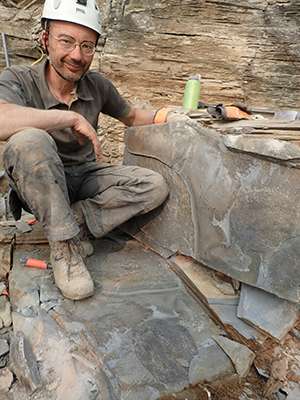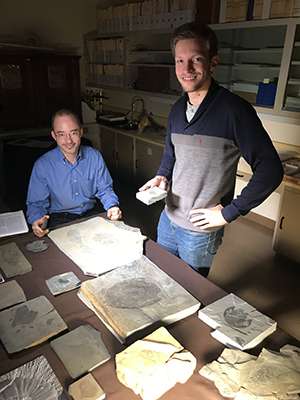September 23, 2021 | Research
One of the biggest Cambrian-era fossils ever found
By ROM/A&S News Staff

Titanokorys gainesi was a giant compared to most animals that lived in the seas during the Cambrian period, most of which barely reached the size of a pinky finger (illustration by Lars Fields/Royal Ontario Museum)
University of Toronto palaeontologists - both alumni!- based at the Royal Ontario Museum (ROM) have uncovered the remains of a huge new fossil species belonging to an extinct animal group in half-a-billion-year-old Cambrian rocks from Kootenay National Park in the Canadian Rockies.
Named Titanokorys gainesi and described in a study published in Royal Society Open Science earlier this month, the new species is remarkable for its size. With an estimated total length of half a metre, Titanokorys was a giant compared to most animals that lived in the seas at that time – most of which barely reached the size of a pinky finger.
The sheer size of this animal is absolutely mind-boggling

“The sheer size of this animal is absolutely mind-boggling – this is one of the biggest animals from the Cambrian period ever found,” says Jean-Bernard Caron (PhD 2005), an associate professor in the departments of Earth sciences and ecology and evolutionary biology (EEB) in the Faculty of Arts & Science at U of T and the Richard M. Ivey Curator of Invertebrate Palaeontology at the ROM.
Evolutionarily speaking, Titanokorys belongs to a group of primitive arthropods called radiodonts. The most iconic representative of this group is the streamlined predator Anomalocaris, which may itself have approached a metre in length. Like all radiodonts, Titanokorys had multifaceted eyes, a pineapple slice-shaped, tooth-lined mouth, a pair of spiny claws below its head to capture prey and a body with a series of flaps for swimming. Within this group, some species also possessed large, conspicuous head carapaces, with Titanokorys being one of the largest ever known.
The head is so long relative to the body that these animals are really little more than swimming heads
“Titanokorys is part of a subgroup of radiodonts, called hurdiids, characterized by an incredibly long head covered by a three-part carapace that took on myriad shapes. The head is so long relative to the body that these animals are really little more than swimming heads,” added Joe Moysiuk (BSc 2018 VIC), co-author of the study, and a PhD student in EEB based at the ROM.

Why some radiodonts evolved such a bewildering array of head carapace shapes and sizes is still poorly understood and was likely driven by a variety of factors, but the broad flattened carapace form in Titanokorys suggests this species was adapted to life near the seafloor.
“These enigmatic animals certainly had a big impact on Cambrian seafloor ecosystems. Their limbs at the front looked like multiple stacked rakes and would have been very efficient at bringing anything they captured in their tiny spines towards the mouth. The huge dorsal carapace might have functioned like a plow,” added Caron, who is Moysiuk’s PhD adviser.
These enigmatic animals certainly had a big impact on seafloor ecosystems. The huge dorsal carapace might have functioned like a plow
All fossils in the study were collected around Marble Canyon in northern Kootenay National Park by successive ROM expeditions. Discovered less than a decade ago, this area has yielded a great variety of Burgess Shale animals dating back to the Cambrian period, including a smaller, more abundant relative of Titanokorys named Cambroraster falcatus in reference to its Millennium Falcon-shaped head carapace. According to the authors, the two species might have competed for similar bottom-dwelling prey.
These and other Burgess Shale specimens will be showcased in a new gallery at the ROM, the Willner Madge Gallery, Dawn of Life, opening in December 2021.
The Burgess Shale fossil sites are located within Yoho National Park and Kootenay National Park and are managed by Parks Canada. Parks Canada works with leading scientific researchers to expand knowledge and understanding of this key period of earth history and to share these sites with the world through award-winning guided hikes. The Burgess Shale was designated a UNESCO World Heritage Site in 1980 due to its outstanding universal value and is now part of the larger Canadian Rocky Mountain Parks World Heritage Site.
Support for the research came from a Natural Sciences and Engineering Research Council of Canada Discovery Grant to Caron and a Vanier Canada Graduate Scholarship to Moysiuk. Additional support for the research and fieldwork came from the Polk Milstein Family, the ROM, the National Geographic Society, the Swedish Research Council, the National Science Foundation and Pomona College.

